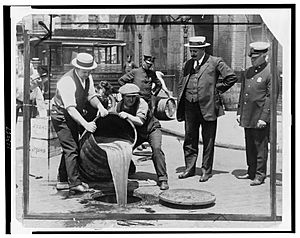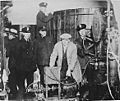Prohibition Era facts for kids
The Prohibition Era was a time in American history when making, selling, and transporting alcohol was against the law. This period lasted from 1920 to 1933. Police officers would stop people who were caught breaking these rules.
Many groups, like the Women's Christian Temperance Union, worked hard to make alcohol illegal. They believed it would solve many problems in society. This ban on alcohol became law through the Eighteenth Amendment to the United States Constitution. States approved this amendment on January 16, 1919. The law officially started one year later, on January 16, 1920.
Prohibition had some good effects, like reducing how much alcohol people drank. However, it also led to new problems. Criminal groups, like the Mafia, started making and selling alcohol secretly. This illegal business, called "rum-running," made these groups very powerful and caused more trouble.
Eventually, people realized Prohibition wasn't working as planned. So, on December 5, 1933, the Twenty-first Amendment ended Prohibition. After that, each state could decide its own rules about selling alcohol.
Images for kids
-
After the 36th state adopted the amendment on January 16, 1919, the U.S. Secretary of State had to issue a formal proclamation declaring its ratification. Implementing and enforcement bills had to be presented to Congress and state legislatures, to be enacted before the amendment's effective date one year later.
-
A policeman with wrecked automobile and confiscated moonshine, 1922
-
A Prohibition-era prescription used by U.S. physicians to prescribe liquor as medicine
-
A temperance fountain erected by the Woman's Christian Temperance Union during the Prohibition era in Rehoboth Beach, Delaware
-
Men and women drinking beer at a bar in Raceland, Louisiana, September 1938. Pre-Prohibition saloons were mostly male establishments; post-Prohibition bars catered to both males and females.
See also
 In Spanish: Ley seca en los Estados Unidos para niños
In Spanish: Ley seca en los Estados Unidos para niños











